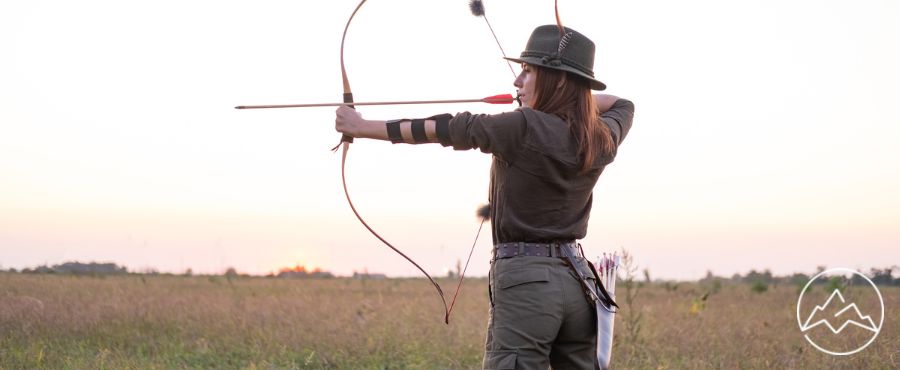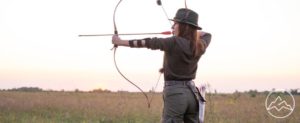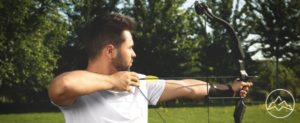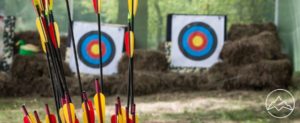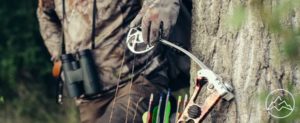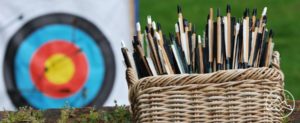In the world of archery, precision and accuracy are paramount. To achieve consistent and accurate shots, archers must master the technique of back tension. Symbolic of control and stability, back tension involves utilizing the powerful muscles of the back to hold the bow at full draw. By doing so, tension in smaller muscle groups is reduced, minimizing the risk of overuse injuries and maximizing shooting performance. This technique requires proper shot setup, with the archer’s elbow aligned with or slightly behind the arrow, ensuring optimal alignment for effective back tension. The transfer to hold involves shifting the weight from the forearm, biceps, and shoulders to the back muscles, creating a foundation of strength and stability. Expanding and aiming necessitate the application of pressure to the release while increasing back tension, allowing for precise and focused shots. Finally, releasing and following through involve maintaining shoulder stability and releasing the bowstring with finesse. By practicing with stretch bands and utilizing mirrors to refine form and strengthen back muscles, archers can enhance their back tension mastery. This not only improves stability and accuracy but also minimizes target panic and prevents shooting errors.
Key Takeaways
- Back tension is crucial for improving accuracy and consistency in archery.
- Proper shot setup and alignment, including the position of the elbow, is essential for effective back tension.
- Practicing with stretch bands and a mirror can help strengthen back muscles and improve form.
- Using back tension for a surprise release can prevent target panic and punching, resulting in a more stable and accurate shot.
Back Tension Technique
The technique of back tension, which involves utilizing the back muscles to hold at full draw and reduce tension in smaller muscle groups, is a crucial aspect of archery that enhances accuracy and consistency while preventing overuse injuries. Common mistakes in back tension technique include improper shot setup and failure to transfer weight from the forearm, biceps, and shoulders to the back muscles. It is important for the archer’s elbow to be in line with or slightly behind the arrow to support back tension. Common misconceptions about back tension include pulling too hard into the back wall of a compound bow and using the smaller muscle groups for holding at full draw. Awareness of these mistakes and misconceptions is essential for archers to achieve stability and accuracy in their shooting. By mastering the back tension technique, archers can improve their form and enhance their precision in archery.
Muscles and Form
Utilizing the knowledge of key muscle groups and proper form is imperative when seeking to enhance accuracy and consistency in the sport of archery. To achieve optimal back tension and improve shooting performance, archers should focus on strengthening the following muscle groups:
- Rhomboids: These muscles play a crucial role in retracting and stabilizing the scapulae, which is essential for maintaining proper posture and alignment during the draw and release phases.
- Latissimus dorsi: The largest muscle in the back, the latissimus dorsi, is responsible for shoulder extension and adduction. Strengthening this muscle helps generate power and stability during the draw.
- Trapezius: The trapezius muscle aids in scapular elevation and retraction, contributing to proper shoulder alignment and stability during the shot.
In addition to understanding the importance of these muscle groups, archers should also be aware of common mistakes that can hinder back tension and accuracy. These include improper posture, such as rounding the shoulders or slumping, and relying too heavily on smaller muscle groups like the arms and shoulders. Engaging in specific strengthening exercises, such as rows, lat pull-downs, and scapular retractions, can help develop the necessary back muscles and improve overall form.
Practicing and Improving
Practicing and improving in the sport of archery involves consistent and focused training on strengthening the relevant muscle groups and refining form. Effective training techniques include using stretch bands and a mirror to improve form and strengthen back muscles. This allows archers to develop the necessary back tension for stability and accuracy in shooting. Additionally, practicing back tension releases can help improve accuracy and reduce target panic. However, it is important to be aware of common mistakes to avoid. One common mistake is pulling too hard into the back wall of a compound bow, which can result in an unstable and weak shot. Another mistake to avoid is punching, which can be prevented by using back tension for a surprise release. By avoiding these mistakes and consistently practicing effective training techniques, archers can master back tension and achieve greater precision in their shots.
Frequently Asked Questions
What are the common mistakes to avoid when using back tension in archery?
When using back tension in archery, there are several common mistakes that should be avoided to ensure accuracy and form. One such mistake is failing to properly engage the back muscles, which can lead to overuse injuries and shooting errors. To determine if the back muscles are being used correctly, archers should pay attention to their shot setup and ensure that their elbow is in line with or slightly behind the arrow. Additionally, pulling too hard into the back wall of a compound bow should be avoided.
How can an archer determine if they are using their back muscles correctly?
Determining back tension accuracy is crucial for archers looking to improve their shooting technique. To ensure correct utilization of back muscles, archers can consider several troubleshooting tips. Firstly, they should pay attention to their shot setup, ensuring that their elbow aligns with or slightly behind the arrow. Additionally, archers can focus on transferring weight from their forearm, biceps, and shoulders to their back muscles during the transfer to hold phase. Regular practice with stretch bands and a mirror can also help improve form and strengthen back muscles, leading to more accurate and consistent shots.
Are there any specific exercises or stretches that can help strengthen the back muscles used in back tension?
Exercises and stretches can effectively strengthen the back muscles used in back tension. Techniques such as rowing exercises, lat pulldowns, and reverse flys target the rhomboids, latissimus dorsi, trapezius, and teres major/minor. Stretching exercises like the standing back stretch and seated shoulder stretch can improve flexibility and prevent muscle imbalances. Strategies for maintaining back tension include proper shot setup and transfer to hold. Mental focus is essential for correct usage and avoiding common mistakes. Different bow styles may require slight modifications in technique.
Can back tension be used effectively with all types of bows, or is it more specific to certain styles?
Back tension can be used effectively with all types of bows, but its impact on arrow trajectory may vary depending on the design of the bow. The role of bow design in utilizing back tension effectively lies in the ability of the bow to transfer the weight from the forearm, biceps, and shoulders to the back muscles. A well-designed bow will provide the necessary support and stability for the archer to maintain proper back tension throughout the shot, resulting in improved accuracy and arrow trajectory.
Are there any mental techniques or strategies that can help an archer maintain proper back tension throughout the shot process?
Maintaining proper back tension throughout the shot process in archery is crucial and can be enhanced through the use of mental techniques and strategies. The importance of mental focus cannot be overstated, as it plays a significant role in achieving accuracy and consistency. Techniques for improving concentration during the shot process include visualization, controlled breathing, and mindfulness exercises. These techniques help archers stay present, calm, and focused, enabling them to effectively engage their back muscles and maintain optimal back tension for a stable and accurate shot.
Conclusion
In conclusion, mastering back tension is essential for archers seeking to improve their accuracy and consistency. By utilizing the back muscles to hold the bow at full draw, archers can reduce tension in smaller muscle groups and prevent overuse injuries. Proper shot setup, transfer to hold, expansion and aiming, and release and follow-through are all important aspects of the back tension technique. By practicing with stretch bands and a mirror, archers can improve their form and strengthen their back muscles. An interesting statistic to note is that mastering back tension not only improves stability and accuracy but also reduces target panic, which can be a significant challenge for archers.

